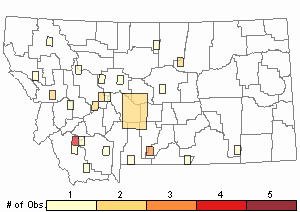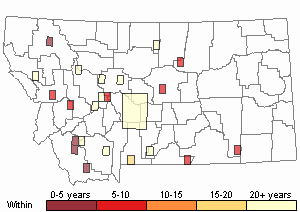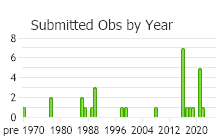View in other NatureServe Network Field Guides
NatureServe
Montana
Utah
Wyoming
Idaho
Wisconsin
British Columbia
South Carolina
Yukon
California
New York
An Orthotrichum Moss - Orthotrichum anomalum
General Description
Plants: Acrocarpous, growing in loose clumps or cushions of upright shoots (FNA 2014), deep- to blackish-green (Lawton 1971) or brownish (Crum & Anderson et al., 1981). Stems sometimes reaching 5 mm in height (FNA 2014), frequently forked (Lawton 1971).
Leaves: Straight, upright and loosely appressed when dry, spreading, sometimes broadly, when damp, 2-3.8 mm in length, lance-shaped, sometimes with ovate tendencies, narrowing to the acute and sometimes dulled or slightly broader-angled leaf tip; leaf edges smooth, curved or rolled back nearly to the leaf apex (FNA 2014); costa not reaching the leaf tip (Lawton 1971).
Leaf Cells: Upper laminal cells chlorophyllous (Crum & Anderson et al., 1981), somewhat round and isodiametric (FNA 2014), sometimes a little elongated (Lawton 1971), with 1 to 3 cone-shaped papillae over each lumen, arranged in 1 cell-layer; lower laminal cells rectangular and sometimes long, the walls thin and occasionally a little knobby (FNA 2014).
Diagnostic Characteristics
The most outstanding distinguishing feature is the capsule projecting beyond the perichaetial bracts with its ribs alternating short and long (FNA 2014).
Range Comments
North American Range
AK to NT, BC to NL and NS, s to WA, AZ, NM, SD, IA, IL, IN, OH, PA, RI, and ME, also TN, VA, and SC; Mexico (FNA 2014). Known in Montana from Sanders and Stillwater Counties (Elliott & Pipp, 2016).
Observations in Montana Natural Heritage Program Database
Number of Observations: 36
(Click on the following maps and charts to see full sized version)
Map Help and Descriptions
Relative Density

Recency



 (Observations spanning multiple months or years are excluded from time charts)
(Observations spanning multiple months or years are excluded from time charts)
Habitat
Stone, most often calcareous, dry stone faces of gorges (FNA 2014), seldom on bottoms of trees and on fence rails along roads coated with limestone powder (Crum & Anderson et al., 1981). Occurring from lowlands to about 9840 feet (FNA 2014).
Reproductive Characteristics
Autoicous. Seta twisted, carrying the capsule beyond the perichaetial bracts, 1-3 mm tall. Capsule 1.8-2.4 mm in length (FNA 2014), shorter than the seta (Lawton 1971), typically with 16 longitudinal ribs alternating short and long (FNA 2014), the short ribs a little less pronounced (seldom absent) (Crum & Anderson et al., 1981), contracted below the opening when dry; stomata sunken and partially covered by adjacent cells; peristome almost always single and typically with a prostome in attendance; exostome of 16 upright to spreading teeth, with fine lines longitudinal above and becoming horizontal below; endostome processes rarely present, not fully formed. Calyptra sheltering the full length of the capsule, papillose, sparsely- to somewhat densely-covered with hairs (FNA 2014).
Stewardship Responsibility
References
- Literature Cited AboveLegend:
 View Online Publication
View Online Publication Crum, H.A. and L.E. Anderson. 1981. Mosses of Eastern North America. 2 volumes. Columbia University Press, New York. 1328 pp.
Crum, H.A. and L.E. Anderson. 1981. Mosses of Eastern North America. 2 volumes. Columbia University Press, New York. 1328 pp. Elliott, J.C. and A.K. Pipp. 2018. A Checklist of Montana Mosses (1880-2018). Updated 3 January, 2020. Montana Natural Heritage Program, Helena, Montana. 73 pp.
Elliott, J.C. and A.K. Pipp. 2018. A Checklist of Montana Mosses (1880-2018). Updated 3 January, 2020. Montana Natural Heritage Program, Helena, Montana. 73 pp. Flora of North America Editorial Committee, eds. 2014. Flora of North America North of Mexico. Volume 28. Bryophytes: Mosses, Part 2. Oxford University Press, Inc., NY. xxi + 702 pp.
Flora of North America Editorial Committee, eds. 2014. Flora of North America North of Mexico. Volume 28. Bryophytes: Mosses, Part 2. Oxford University Press, Inc., NY. xxi + 702 pp. Lawton, E. 1971. Moss Flora of the Pacific Northwest. Hattori Botanical Laboratory. Japan: Yamabuki-cho, Shinjuku-ku, Tokyo. 362 pages plus appendices.
Lawton, E. 1971. Moss Flora of the Pacific Northwest. Hattori Botanical Laboratory. Japan: Yamabuki-cho, Shinjuku-ku, Tokyo. 362 pages plus appendices.
- Additional ReferencesLegend:
 View Online Publication
View Online Publication
Do you know of a citation we're missing? Elliot, J. C. 1993. Second checklist of Montana mosses. Unpublished report. U.S. Forest Service, Region 1. Missoula, MT. 45 pp.
Elliot, J. C. 1993. Second checklist of Montana mosses. Unpublished report. U.S. Forest Service, Region 1. Missoula, MT. 45 pp. Flowers, S. 1973. Mosses: Utah and the West. Brigham Young University, Provo, Utah. 567 p.
Flowers, S. 1973. Mosses: Utah and the West. Brigham Young University, Provo, Utah. 567 p. Lawton, E. 1971. Keys for the Identification of the Mosses on the Pacific Northwest. Reprinted from 'Moss Flora of the Pacific Northwest'. Published as Supplement No. 2 of the Journal of the Hattori Botanical Laboratory. Nichinan, Miyazaki, Japan. 66 pp.
Lawton, E. 1971. Keys for the Identification of the Mosses on the Pacific Northwest. Reprinted from 'Moss Flora of the Pacific Northwest'. Published as Supplement No. 2 of the Journal of the Hattori Botanical Laboratory. Nichinan, Miyazaki, Japan. 66 pp. Smith, A.J.E. 1980. The Moss Flora of Britain and Ireland. Cambridge University Press, Cambridge. 705 pp.
Smith, A.J.E. 1980. The Moss Flora of Britain and Ireland. Cambridge University Press, Cambridge. 705 pp.
- Web Search Engines for Articles on "An Orthotrichum Moss"





